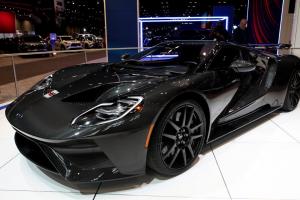The History Of Ford
The History Of Ford
NEW YORK, NEW YORK, UNITED STATES, October 21, 2021 /EINPresswire.com/ -- Passage Motor Company is an American auto organization situated in Dearborn, Michigan. The organization was established on the sixteenth of June 1903 and is right now the world's fifth-biggest automobile organization on the planet based on overall vehicle deals.Early Years of Ford
Henry Ford constructed his first auto at his home in Detroit in 1896. He called it a quadricycle. This prompted establishing the organization, the Detroit Automobile Company in 1899 which was subsequently renamed to Henry Ford Company in 1901. Nonetheless, he left the organization with the rights to his name and $900 after several issues with his financial sponsors. With the assistance of his acquaintance, Alexander Y. Malcomson, Ford began another automobile organization under the name "Ford and Malcomson". With the help of different financial investors, Ford Company was incorporated on June 16, 1903, with every one of the 12 investors claiming an overall of 1000 shares. Ford and Malcomson together held 51% of the new organization in return for their previous ventures.
After a few issues with Malcomson and with the demise of Gray, a major investor in the organization, Ford became the president of the automobile company in 1906. Ford was subject to lawsuits or threats from the Association of Licensed Automobile Manufacturers early in its history. The Association claimed patent rights to most gasoline-powered automobiles. After several years of legal wrangling, the Association eventually dropped its case against Ford in 1911.
The coal shed on Bagley Street, Detroit was where Henry Ford constructed his first vehicle in 1896. During its initial years, the organization created a scope of vehicles assigned, sequentially, from the Ford Model A (1903) to the Model K and Model S (Ford's last correct hand guiding model) of 1907.
In 1908, Henry Ford presented the Model T. Early models were made in a leased manufacturing plant on Mack Avenue, Detroit, Michigan, in no time and later on Piquette Avenue. The principal Model T was made at the Piquette Avenue plant. In the vehicle's first entire year of creation (1909), an excess of 10,000 T models was delivered. As interest in vehicles expanded, the organization moved creation to the bigger office in Highland Park in 1910.
69,762 T models were delivered in 1911 and 170,211 were created in 1912. By 1913, the organization had built up all the fundamental advancements for sequential construction systems and large scale manufacturing. Ford dispatched the world's first versatile sequential construction system that year, decreasing undercarriage gathering time from 12 1⁄2 hours in October to 2 hours and 40 minutes (in the long run 1 hour and 33 minutes) and expanding yearly creation to 202,667 vehicles. The Ford Advertising Company guaranteed that if the business volume arrived at 300,000 between August 1914 and August 1915, it would part the benefit. At that point, the business volume would arrive at 308,162 of every 1914 and 501,462 out of 1915, by 1920 the yearly creation would be more than 1,000,000.
Ford Assembly Line (1913)
Ford accomplished global status with the development of Ford of Canada in 1904. However, in 1911 the company started extending quickly abroad, opening assembly plants in Ireland (1917), Great Britain, and France, trailed by Denmark (1923), Germany (1925). , Austria (1925) and Argentina (1925). A plant was opened in Yokohama, Japan (1925), and industrial facilities in South Africa (1924) and Australia (1925) opened as auxiliaries of Ford in Canada because of the particular tax rules for Commonwealth nations.
Before the finish of 1919, Ford had delivered half of the vehicles in the United States and 40% of the vehicles in the UK. By 1920, half of all vehicles in the United States were Model Ts. The mechanical production system changed the business. Before long organizations were compromised with liquidation Of the 200 American automakers in 1920, just 17 were left in 1940.
It also changed technology. Before the assembly line, Model T could utilize an assortment of colors, including red, blue, and green, but not black. Now, color has become a bottleneck underway. In 1915, Henry Ford took a ship on a peacekeeping mission to Europe and joined different pacifists to stop World War I. This led to its extending popularity. Therefore, Ford kept on supporting the battle in which the Model T became the basis of allied military vehicles such as the Ford 3-ton M1918 tank and the 1916 ambulance.
Ford Motor Company started with limited diversification during the 1950s and 1960s, yet by the 1990s it had turned its consideration back to the auto business and financial services. In 1989-90, Ford procured Jaguar, a British luxury automaker. Aston Martin turned into an entirely possessed auxiliary in 1993. Resulting acquisitions included Hertz Corporation, a vehicle rental organization in 1994, the Volvo Auto Division in 1999, and the Land Rover sport utility vehicle brand in 2000. Ford also purchased Mazda Motor Company. However, with issues from the get-go in the 21st century, Ford began selling these brands. Ford sold Hertz in 2005 and Aston Martin in 2007. In 2008 Jaguar and Land Rover were offered to Tata Motors Ltd. from India. Ford started selling its Mazda partakes in 2008 and sold them all together in 2015.
Ford In The 21st Century
In December 2008. President Bush declared a monetary bailout to help the "three major" automakers Chrysler LLC, General Motors, and Ford Motor Company prevent the breakdown of the nation's unsettled auto industry. The plan immediately got $13.4 billion in government credits from the Non-Performing
Mr 212
212AutoWorld
+1 212-470-9349
email us here
Visit us on social media:
Facebook
Twitter
LinkedIn


